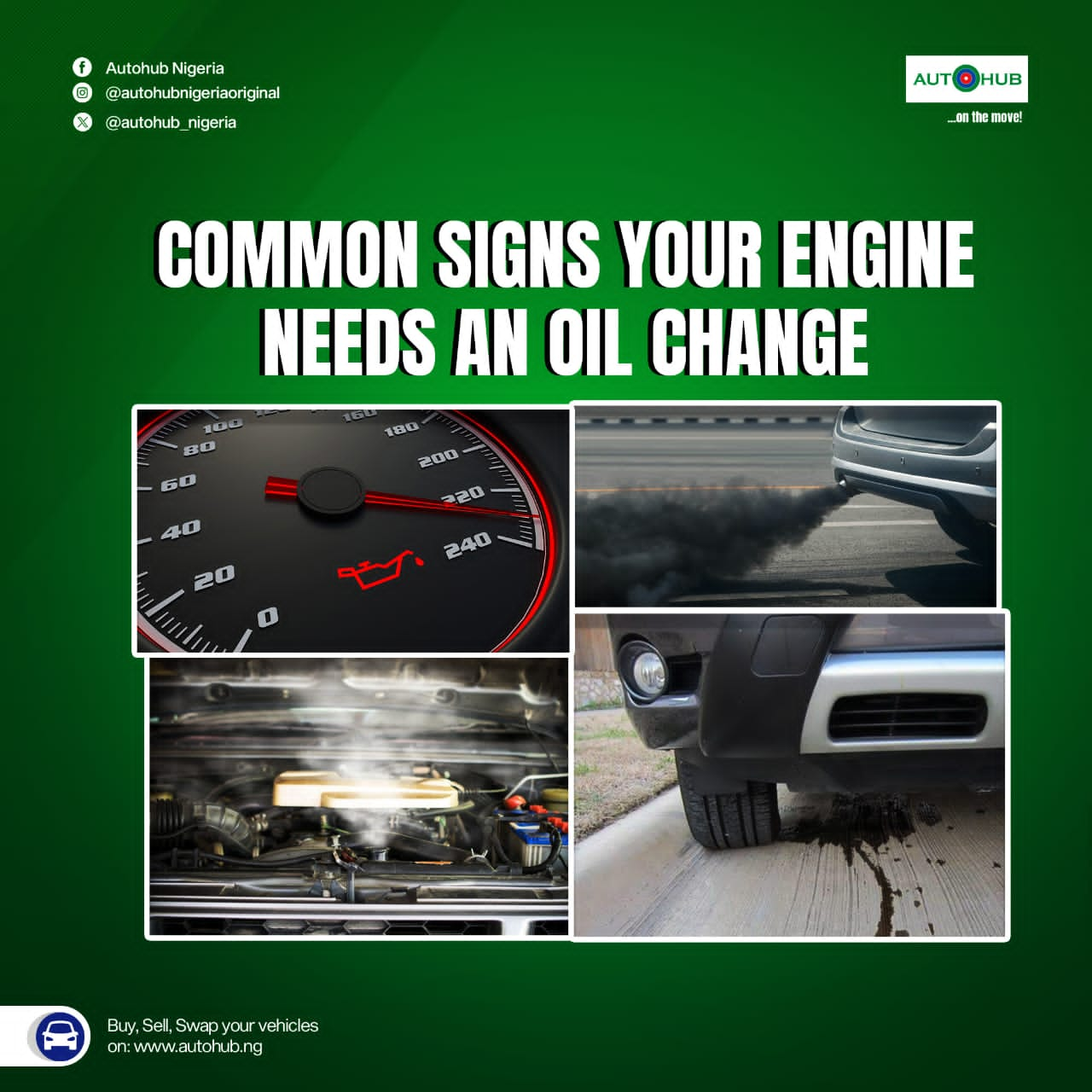Common Signs Your Engine Needs an Oil Change

Oil is to your car just as blood is to your body – but over time, your body can purify the blood and produce new blood cells. Your car can’t. Oil changes are part of regular, ongoing maintenance, and while they may seem relatively simple, they’re actually one of the most important types of car maintenance you need to keep your vehicle healthy and last longer.
Not changing your engine oil regularly can cause a number of problems, from reduced fuel economy to serious engine damage to complete engine failure! How do you know when to change your engine oil? We’ve listed the common signs that your engine needs an oil change or additional maintenance below. Enjoy…
The need for regular oil changes
Before we get into the signs that your engine needs an oil change, it’s important to understand a little about engine oil, the different types of oil available on the market, and why you should change your oil. We’ve been talking about Motor oil and some might ask – what is it? Motor oil is a viscous liquid that helps lubricate and cool your car’s engine.
All car engines need engine oil, but the type, weight, and viscosity of oil varies from engine to engine. It will also vary depending on when the engine was built. Newer engines have stricter requirements for fuel economy and gas mileage – which means engine clearances are tighter. Most engines today use thinner oil than they did 10, 20, or 30 years ago.
There are two main types of motor oil: mineral oil and synthetic oil. Mineral oil is a petroleum product derived from crude oil, just like gasoline. In contrast, synthetic oils are developed in laboratories. There are also mixtures of these two oils. Mineral oil is usually cheaper, but doesn’t last as long. Synthetic oils are more expensive, but require fewer natural resources and last longer (thousands of miles in most cases).
Your engine is designed to use a certain weight of oil, usually listed in your owner’s manual or on the engine oil cap. It can read 0W20, 5W20 or 5W30.
Some vehicles use higher weights, but these are becoming less common (10W30, 10W40, 20W50, etc.).
Be sure to follow the vehicle manufacturer’s recommended oil weight for your engine, otherwise fuel economy may decrease over time or even damage the engine over time.
Why is oil important?
Engine oil is important for several reasons:
The most important reason for engine oil is lubrication. It keeps all the moving parts protected, and prevents them from rubbing against one another. Without oil, metal-on-metal wear would destroy your engine in a very short period of time. Engine oil creates an atoms-thin layer between moving parts, preventing full contact and prolonging engine life.
The second reason for engine oil to be used in your car is cooling. Most of the cooling needed is supplied by the coolant system (radiator, thermostat, water pump, etc.). However, engine oil does provide some supplemental cooling for areas of the engine where coolant cannot reach.
Engine oil is also responsible for helping to clean the engine, removing debris like metal filings and other potentially damaging deposits.
When should I change my oil?
There is no single oil change interval recommended for all engines any longer. Once upon a time, most mechanics recommended changing your engine oil every three months or 4,800 km (3,000 miles), whichever came first. That is no longer the case because with higher quality oils and oil blends these days, we can now drive longer between oil changes. Some oil types can even last up to 16,000 km (10,000 miles) between changes (high-end synthetic oils).
However, the best rule of thumb is to follow your automaker’s recommendation, which should be listed in your owner’s manual. If you don’t have your manual, go with the three-months (two to three long-distance journeys in some cases) rule for conventional mineral oil, and follow your mechanic’s recommendation for synthetic oils.
What is viscosity?
Oil viscosity is nothing more than a term used to express oil’s ability to lubricate your engine and protect moving parts. Over time and through heat, oil thins out and becomes less viscous. This reduces its viscosity and its ability to protect your engine. Thus, the need to change your oil regularly.
What will happen if I drive without oil?
If you were to drive your car with low engine oil, it may do nothing more than result in minor excess wear to internal engine components. It really depends on how low the oil level is. You are generally safe up to about a quarter low. However, if you were to drive with no engine oil at all, the engine would quickly seize up, and you would need to replace the entire engine.
What will happen if I put the wrong oil in my car?
Again, it really depends on the type of oil you add to your engine. In some instances, you’ll notice no difference at all. In others, you’ll see reduced fuel economy. This should be no problem to switch between two different types of oil with different viscosities.
However, you may lose some properties depending on the type of oil you decide to use. For example, going from 5W40 to 5W30 loses some of the benefits at higher temperatures, as a higher number after the W indicates that the oil is more efficient at higher temperatures. In very serious cases, you could cause excess wear to the oil pump, leading to a shorter engine life.
Signs that you need to change your oil
Now that we’ve covered a bit about what engine oil is, why changing it matters, and the type of oil on the market, let’s delve into how you can tell if you need to have your engine oil changed. These common oil change signs are here to guide you:
1. Check your mileage sticker or leaflet
Most mechanics will indicate when you should return. Some workshops will either issue you a leaflet or place a clear sticker on the inside of the windshield on the driver’s side of the car. Here, you’ll find the date and/or specific mileage when you should return.
2. Dark and or dirty oil
When oil is new, it is clean and is usually light to dark gold in colour (this largely depends on the weight/thickness). Over time and through use, oil darkens. This is due to heat, but also to the impurities and debris it picks up while being pumped through the engine. Checking the dipstick regularly will let you keep an eye on the colour of your engine oil as it changes over time. If you pull out the dipstick and notice that the oil is dark, it’s time to change it.
3. Engine noise/knocking
Engine oil’s primary job is lubrication. When there’s not enough oil, moving parts within the engine do not get the lubrication they need. This allows them to make physical, metal-to-metal contact, which can cause a light tapping or knocking sound. You may also hear lifters and/or cam bearing noise due to low oil pressure within the engine if the level is low. Engine noise can also occur when the oil is old and has lost its viscosity (ability to lubricate).
Note that this is not the same as “engine knock” – it’s more of sputtering noise, which is caused by an incorrect air-to-fuel ratio. If you hear engine noise, it is crucial to check your oil level and have it changed immediately. This is a tell-tale oil change sign. It might even be necessary to add oil to the engine to make it safer to drive down to the mechanic shop before the commencement of any repairs.
4. Exhaust smoke
In most cases, your car’s exhaust will be mostly invisible, although it will have a slight smell to it. Note that petrol engines produce very little coloured exhaust smoke, unlike diesel engines, which produce black, soot-like exhaust smoke. However, if you notice that you have blue-ish smoke coming from your exhaust, it’s a sign that there’s something wrong.
Generally, blue smoke is caused by oil seeping into the engine and being burned along with the fuel. Your engine will be low on oil as well. There is also the possibility that there is an external oil leak, and the oil is dripping onto the exhaust system. Note that if the exhaust smoke is grey-ish, it is more likely to be caused by an incorrect fuel-to-air ratio, as your engine is burning “rich” that is – too much fuel is being combusted.
5. You smell oil inside the car
If you smell oil inside the car, it means just one thing – you have an oil leak, and it’s dripping onto a hot part of the engine or exhaust and is burning away. There are plenty of potential areas for oil to leak, including from the following:
Oil plug: This is the drain plug in your engine’s oil pan. It is taken out during oil changes and replaced. However, if it is not tightened properly, or the gasket has degraded (if present), it may drip oil.
Oil filter: The oil filter cleans particulate matter from the oil as it passes through, and should be replaced after each oil change. If the filter is not seated properly or has deteriorated, it can leak oil. The filter can also be damaged, causing an oil leak.
Valve cover gasket: Oil can leak from around the edges of the valve cover gasket at the top of your engine, and then down the side of the engine. Depending on your engine size, you may have more than one valve cover gasket.
Oil sending unit: The oil sending unit, or pressure switch, is usually located on the back of the engine and can leak oil down the block if the gasket is damaged.
Oil pan gasket: The oil pan gasket seals the oil pan to the bottom of the engine. It can leak at any point around its circumference.
Head gasket: A head gasket leak can cause oil to spill down the head of the engine (and usually requires engine tear down to replace).
Front/rear main seals: A leaking front or rear main seal can cause engine oil to leak down the left or right side of the engine, or down the front/back of the engine, depending on the drivetrain type.
Many minor oil leaks are fine to leave as is, so long as your mechanic monitors them over time at each oil change/maintenance service. However, if you are smelling burning oil in the interior of your car, then the leak is severe, and must be repaired immediately. Failure to do so will result in damage to the engine, or even its complete destruction. In some cases, it may even lead to an unfortunate vehicle fire if the oil on the engine ignites.
6. Oil check light on the dashboard
Your dashboard houses a number of important warning lights, including the check engine light, battery light, and more. It also includes an oil check light. This light is red, and shaped like an oil can with a drip coming from the spout. As you might assume, this is one of the easiest oil change signs to interpret since your car is actually telling you it needs an oil change.
If this light comes on while you’re driving, pull over as soon as it is safe to do so and turn off your engine. The light could indicate a couple of different things, but generally comes on when the oil pressure in the engine drops below safe levels. Usually, this is because there is too little oil in the engine. However, it can also mean that the pump/sending unit is faulty and needs to be replaced.
Check the oil level as soon as it is safe. If it is low, you’ll need to top it off with fresh oil. Once you’ve added oil, crank the engine and see if the light goes off. If it does, get the oil changed soon and have the mechanic check for leaks that might have led to the low oil condition.
If the light does not go off, it’s best to call for roadside assistance, as it means that there is insufficient oil pressure in the engine, most likely due to a failed oil pump. Some engine models can operate with very low oil pressure without sustaining too much damage, but most cannot. It is best to play it safe and call for a tow.
7. Oil change reminder light
Newer vehicles usually have two oil lights – one is a red warning light discussed above. The other is an oil change warning light. This oil change sign light has nothing whatsoever to do with your oil level or the amount of oil pressure within the engine. It automatically comes on at certain mileage points as a reminder that it is time to have your oil changed. Your mechanic should reset this light at each service.
If it has come on, it means that you have gone beyond your manufacturer’s recommended service interval mileage, or that the mechanic did not reset the light at your previous service. Check to see if there is an oil change sticker on your windshield. If there is, compare the mileage written on that with the mileage on your odometer. If the odometer reads higher, then you’ve missed your oil change window and you need to have it changed soon. If the sticker mileage is higher, then the mechanic probably forgot to reset the light.
8. Oil level is low
It’s important for all car owners to know where their oil dipstick is located, and to check the level on a regular basis. This allows you to keep an eye on oil consumption, colour and condition; and avoid problems before they become serious. Ideally, you should check your oil level weekly, but once per month is usually safe as well.
If you check your dipstick and the oil level is low, it may mean any number of things. First, it’s considered normal for some engines to use a small amount of oil between oil change intervals. The exact amount differs from automaker to automaker and model to model, as well as with time. For instance, for some Honda Accords made during the 2000s, it is considered normal for the engine to burn up to a quart of oil between oil changes. This oil is not leaked, but burned off.
If the oil is below the safe level on the oil dipstick (some dipsticks use full and safe marks, while others use hashmarks to indicate the safe range), you’ll need to top it off. In most instances, the bottom mark on the dipstick represents the engine being a quart low. If you are within the mileage for your oil service, you may be fine just topping off.
However, if you are at your oil change mileage or beyond, it is important to have your oil changed. It’s also important to have the mechanic you use – check for oil leaks during the service. As mentioned, some oil consumption may be normal, but it may also be caused by a leaking gasket or other problems.
9. Excessive mileage
We rely on our cars to get us to and from work, back and forth from the store, and more. We also rely on them to take us longer distances – your annual “December” vacation trip to the village is a great example. However, long drives put a lot of wear on the engine, and on the engine oil. You should have the oil changed immediately before the trip, and then again once the trip is over. Why, though? Because prolonged use and long periods of time at high temperatures degrade oil more quickly than normal use. The oil will darken more quickly, pick up impurities faster, and lose its ability to lubricate in a much shorter amount of time. Changing your oil before and after a long trip ensures that you don’t inadvertently cause damage to the engine by running oil that’s lost its ability to lubricate.
If you own a used car, you must be even more diligent regarding oil changes because it is likely that your vehicle has already racked up some miles. It is recommended that as your car’s odometer continues to grow larger, you schedule or perform oil changes more frequently and use oil specially designed for high-mileage vehicles. It’s worth noting that some modern cars and ultra high quality oils as stated previously can go well beyond 2/3 trips but it is usually advised to play it safe and change the oil after a trip, especially with older cars.
10. Car stalling
Many modern vehicles are designed with several fail-safes to help protect the engine in adverse conditions. One of this is an automatic shutoff when the oil pressure drops to a certain level, or the oil level drops too low (note that this is not the case for all cars). This causes the engine to stall and die. However, engine stalling itself is very damaging to the engine, as it could lead to damage to the pistons, head and other components.
11. Overheating
Last but not the least is overheating – generally isn’t associated with low oil levels, although it should be. It’s usually noticed if your coolant is low, but low oil can also cause the engine to overheat. This can occur even if your coolant level is fine. If there is too little oil in the engine, it will continue to heat up because it has no opportunity to cool. This means that the engine coolant has a harder time siphoning off excess heat, and you’ll notice your temperature gauge start to climb (note that your temperature gauge indicates coolant temperature, not oil temperature).
If you notice your coolant gauge rising into unsafe levels (yellow or red on the gauge), find somewhere safe to pull over and let it cool down. While the engine is cooling off, check the oil level. If it is low, it will need to be topped off before driving to a mechanic. You should also check your coolant level, but do not do this until the engine is completely cool. Hot coolant can explode out of the reservoir or radiator and cause serious burns.
Once the engine has cooled down, check the coolant level and top it off if necessary. Never run your engine if it is overheating as it can cause serious damage up to, and including cracking the engine block – which essentially destroys the engine.
In the end, it is vital that you keep a close eye on the oil condition and level in your car. Always ensure that it is being serviced at the right intervals, and that you are using the right type and oil weight for your engine as per manufacturer specifications. Any signs of low oil, low oil pressure, oil leaks, or overheating should be addressed immediately. And as always, thanks for reading and do have a safe drive out there.











No Comments